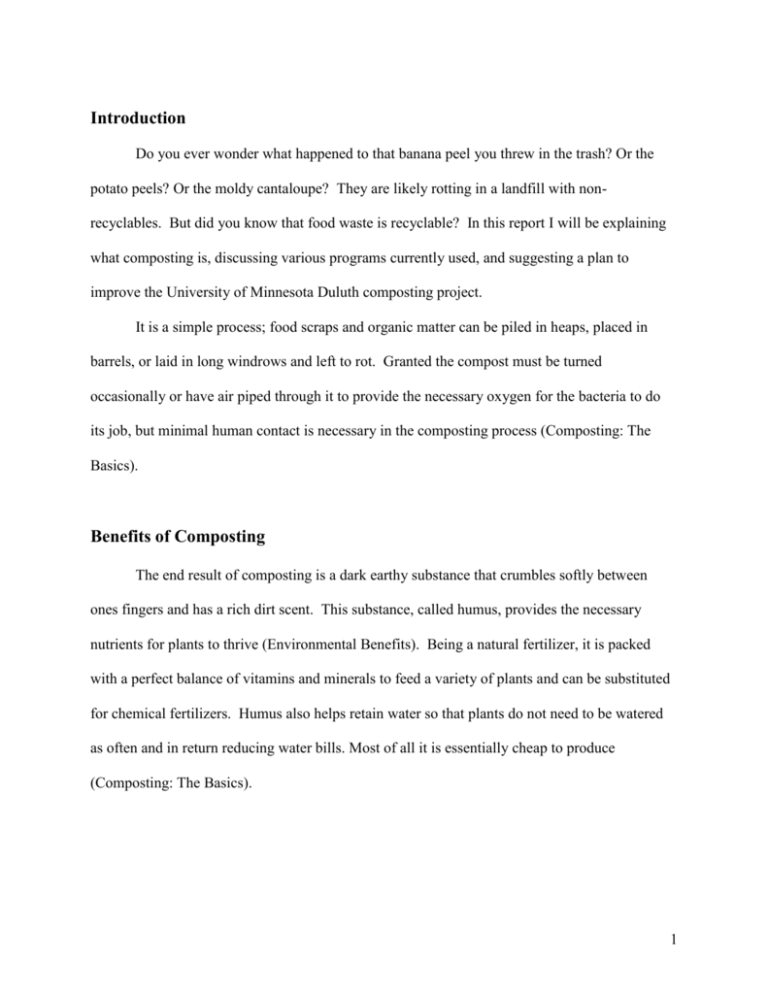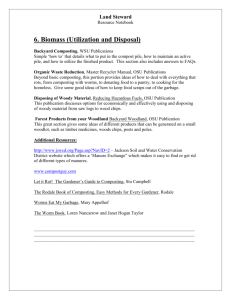composting-feasibility-report
advertisement

Introduction Do you ever wonder what happened to that banana peel you threw in the trash? Or the potato peels? Or the moldy cantaloupe? They are likely rotting in a landfill with nonrecyclables. But did you know that food waste is recyclable? In this report I will be explaining what composting is, discussing various programs currently used, and suggesting a plan to improve the University of Minnesota Duluth composting project. It is a simple process; food scraps and organic matter can be piled in heaps, placed in barrels, or laid in long windrows and left to rot. Granted the compost must be turned occasionally or have air piped through it to provide the necessary oxygen for the bacteria to do its job, but minimal human contact is necessary in the composting process (Composting: The Basics). Benefits of Composting The end result of composting is a dark earthy substance that crumbles softly between ones fingers and has a rich dirt scent. This substance, called humus, provides the necessary nutrients for plants to thrive (Environmental Benefits). Being a natural fertilizer, it is packed with a perfect balance of vitamins and minerals to feed a variety of plants and can be substituted for chemical fertilizers. Humus also helps retain water so that plants do not need to be watered as often and in return reducing water bills. Most of all it is essentially cheap to produce (Composting: The Basics). 1 Studies conducted by the EPA have also shown that compost can be used to help prevent the spread of plant diseases and pests as well as increase the yield of agricultural crops. It can be used to remediate depleted soils and aid reforestation. Compost can also be used to break down many toxic substances and is even able to be used to clean superfund waste sites allowing savings greater than 50 percent over modern pollution removal techniques (Basic Information). Composting is the most natural approach to the food cycle. The soil gives nutrients to the crops, we eat the produce and it gives us energy. The parts we don’t eat can be composted and used to continue to nourish the crops. Sadly this process is rarely followed. The food scraps generally end up at a landfill. Although food residuals and yard trimmings make up 23 percent of the waste stream in the United States, very little is recycled. In the year 2000 only 2.6 percent of food waste was composted (Basic Information). (Yard trimmings are banned from landfills resulting in approximately 56.9 percent being recycled.) Since the year 2000 the effort to compost food wastes has been increased significantly but there is still work to be done. Composting Programs Composting programs can take many forms from small scale backyard operations to city wide mandatory law. The following pages describe a variety of composting methods with an emphasis on those of colleges and Duluth. Many people, particularly in rural areas, compost on their property. A small pile of peelings and vegetable scraps sitting near the corner of a garden or a barrel type composting container is often used. This can keep around 700 lbs of food waste out of landfill per household every year (Composting: The Basics). However, it is not recommended for people with these 2 types of composting operations to attempt to compost meat scraps or dairy since it may attract animals. These small operations are helpful in reducing landfill waste and the owners benefit dually with decreased garbage removal and nutrient rich humus for their use. On a much larger scale several cities have implemented mandatory composting laws. The most extensive is San Francisco’s which requires all individuals as well as businesses to compost food scraps (NPR). Collection bins for the food waste are provided by the city as well as the pick up. The law has been widely accepted and embraced by the citizens even before it was passed. University Programs Universities typically try to remain on the forefront of recycling and environmental sustainability programs. Many colleges have composting programs although they very greatly in type and size. The following discusses several Colleges and Universities who have been taking strides to reduce their environmental impact. Lakeland College Lakeland College in Sheboygan, Wisconsin runs a small pre-consumer recycling program contributes about 25 lbs of scraps per day to an open heap composting pile on their property. The lack of a larger composting facility prevents their program from expanding to include meats and bones as well as post-consumer waste. Lakeland College also promotes a “Clean Plate” program to cut down on post-consumer food scraps. Their program has also had setbacks; Dining Services Director, Greg Hopkins, explained how he has had to repeatedly separate the 3 food scraps from the garbage in the kitchen at Lakeland College simply due to the indifference of his employees (Hopkins). Middlebury College Middlebury College, Middlebury, Vermont began composting in 1993 and has been able to divert 75 percent of their food scraps from landfills to an onsite composting facility. Middlebury states that in 2009 their composting and recycling programs saved $94,001 in landfill fees. They are operating a very impressive program composting about 300 tons of food per year using a turned windrows system. They own heavy machinery to collect the food scraps, haul them to the composting site and to turn the compost. They hire a composting company to bring in a screener to sift the humus once a year (Middlebury). They have also begun placing food waste collection points around dorms and offices on campus and have found it to be successful. The custodial staff collects these bags of food scraps and places them in a collection zone (Middlebury). Middlebury is a very good example of student involvement with a recycling program and environmental stewardship. College of St. Scholastica The College of St. Scholastica (CSS) is currently operating a very effective composting program. They have the similar resources available as UMD; however they have taken greater initiative towards reducing their food scrap waste. St. Scholastica’s Dining Center features “trayless dining” meaning simply that the dining areas have discontinued the use of plastic trays. Going “trayless” has brought great savings through the lessening of energy consumption. No trays mean fewer dirty dishes to be washed 4 saving water as well as electricity. It also helps reduce the amount of food wasted and consumed (Teske). Students must carry a plate of food rather than piling their tray full of food they may or may not eat. Students still have the option of eating as much as they want they just have to take a trip back for seconds. St. Scholastica has also switched all disposable eatery to compostable varieties for use in the food court. This enables all food scraps thrown into the waste bins at the food court to be composted along with the silverware, cups, plates and napkins (Teske). The importance of being good stewards of the earth through recycling and wasting little are instilled in the student body from the moment they begin their learning at CSS and is reiterated throughout their education. Students also are more aware of the composting which takes place at the school, because they scrape their food scraps into collection bins themselves. Student groups record the amounts of food waste and graph the results on a dining center window further increasing the awareness of the students (Teske). University of Colorado Boulder Sierra magazine voted The University of Colorado Boulder (UCB) the best sustainable campus in 2009 (UCB). The school’s sustainability program is top notch and, surprisingly, their school is several times larger than UMD, and much larger than a small private college like Middlebury. Policies throughout every aspect of the school system must work together to help achieve this standard. They achieve this in the dining centers through composting and minimizing food waste. The University focuses on hosting “zero-waste” meals for special events held by the school (UCB). These events have compostable flatware and utensils and provide recycling and 5 composting bins, no trash receptacles are necessary since everything can be recycled. Composting of pre- and post-consumer food waste kept more than 183 tons of nutrient rich waste out of landfills (UCB). Several special activities are held to increase student awareness and connectivity with the food process and sustainability. The school also supports bringing your own travel mug to the dining centers in order to lessen the number of dirty dishes and disposable cups used (UCB). Recommendations for the University of Minnesota Duluth The University of Minnesota Duluth (UMD) is active in its efforts to recycle and cut down as much waste and energy usage as possible. The composting effort has been quite successful thus far, but there is always room for improvement. Four primary areas can be made much more efficient very easily. Dining Center Firstly, the Dining Center is the source of most of the pre- and post-consumer food scraps collected. Serving approximately 5000 meals a day they collect nearly 130,000 pounds of food waste in 2008 (A Serving of Sustainability). This figure represents inedible pre-consumer food waste, but also a large post-consumer waste of food. By decreasing the amount of food students waste significant financial and environmental savings can be reached. This reduction in food waste can be made possible by beginning a “trayless” system like St. Scholastica uses. When students take a tray it is made very easy to pile an unnecessarily large proportion of food on their trays and waste much of it. By simply removing the tray from the scene the students fill their plates with as much as they can hold and return for seconds if 6 they are still hungry. However, Tim Bushnell stated that a trayless system would be dangerous because of crowds and hot soup which cold spill and injure students. In order to take this potential hazard into consideration, trays could be available near the soup counter enabling students who wish to have soup to use a tray. Trays could also remain available at the hot entrée counter upon request of students needing a tray. Issues with students inability to carry sufficient amounts of beverage can be easily remedied by replacing the tiny cups (see Figure 1) currently featured in the Dining Center with a larger variety and by following UCB’s example and encouraging students to bring their own mug. Another consideration is the means of piling plates and glasses to be hauled to the composting and dishes area. Since the food scraps are sorted by kitchen Figure 1: Tiny Cup at DC staff it would be simple with the “trayless” system to simply provide racked bins for students to place their dirty dishes and silverware. Student awareness is the forefront of improving UMD’s sustainability program. As it stands very few students are actually aware of the composting program at UMD or of the environmental impact their actions have regarding dining. To increase this awareness I would like to propose that statistically based facts regarding composting, recycling, consumer waste and preventative measures be placed around the dining areas. These signs should be simple single sentence facts which can be made as magnets and placed above sneeze-guards, on silver ware counters (see Figure 2), near the grill and can also be printed and placed in the napkin holders. 7 Students often fall into a routine of their daily route through the dining center. So, periodically rotating the magnets among the counters and the napkin holders around the dining area, students would continuously be able to learn new facts and become more Figure 2: A View of the Buffet aware of the University’s efforts and in return increase their own as well. Food Court The second area which could easily be improved is the Food Court. There is no collection system for post-consumer food waste in this area. This could be easily remedied by switching the baskets, cups and papers used to a compostable variety (since the utensils are already compostable) this would enable all waste from the food courts to be composted. The trash cans would then be replaced with marked composting bins along with recycling bins and small trash cans for trash brought from outside the Food Court. As contamination of composting bins would be a consideration, this could be taken into account by simply making the composting bins slightly more difficult to use than nearby trash bins. A push button opening perhaps would deter individuals from throwing their plastic bottle into the composting bin in the same manner that a small round hole in the lid of an aluminum recycling bins lessens contamination from paper. 8 It will be important to make students aware of the recycling program used by the food courts. A campaign similar to that for the Dining Center will be used to increase the awareness of students. This will also help reduce the amount of contamination, since students will understand the program more thoroughly. On-Campus Drop-Site Thirdly, I would like to propose that a drop-site for food scraps be made available on campus. This would allow students who live off campus the ability to compost easily by bringing small biodegradable bags of food scraps with them to drop off on their way to school. This would be a considerable perk for students on campus as well. Students living in the on-campus apartments consume most of their food at home resulting in most of their food waste being thrown into their trash cans. By making a drop-site available at a location such as pictured in Figure 3, the collection of food scraps from these additional areas would be much simpler. Students could bring their scraps to the small composting bins located in the recycling areas. The composting bins would be emptied daily by the grounds crew and the scraps would be brought to the drop-site. Figure 3: Potential Drop-site Location 9 Catered Events Lastly as UMD hosts many catered events both large and small it should become standard policy to make these “zero-waste” events. This would not be a difficult change. Compostable flatware, cups and silverware would be used as needed. Otherwise reusable “China” should be used. Conclusion These suggestions would greatly improve the public opinion of UMD as well as help produce more well-informed students. They are all very simple to incorporate into the current sustainability program and offer great benefits for little cost. Most of all, these changes are beneficial to the environment and that should take the highest priority. By modifying the current program UMD can set an example for schools everywhere for food waste management. 10 Sources Cited A Serving of Sustainability. Poster located in UMD Dining Center. Sources from World Wide Web: http://www.d.umn.edu, www.addinguptozero.com. Basic Information. . Epa.gov. Retrieved 15 June, 2010 from World Wide Web: http://www.epa.gov/osw/conserve/rrr/composting/basic.htm Bushnell, Tim. 2010 Principal Manager of Dining Center UMD. Interview with author, July 22. Carlton.edu. Link to: Bon Appétit’s Waste Commitment. Retrieved 26 June, 2010 from the world wide web: http://www.cafebonappetit.com/carleton/env/waste/waste_commit.html Colorado.edu. Sustainability. Retrieved 15 July, 2010 from World Wide Web: http://housing.colorado.edu/dining/s_sustainability.cfm Composting—Organic Materials. Epa.gov. Retrieved 15 June, 2010 from World Wide Web: http://www.epa.gov/osw/conserve/rrr/composting/basic.htm Composting: The Basics. Howtocompost.org. Retrieved 20 June, 2010 from the World Wide Web: http://www.howtocompost.org/info/info_composting.asp Css.edu. St. Scholastica establishes Environmental Stewardship group to 'move faster in the right direction.' Retrieved 25 June, 2010 from World Wide Web: http://www.css.edu/About/News-Center/St-ScholasticaNews/Environmental-Stewardship-Council.html Darley-Hill, Susan. 2010 Environmental Program Coordinator. Interview with the author on composting through WLSSD, 24 June. Environmental Benefits. Epa.gov. Retrieved 15 June, 2010 from World Wide Web: http://www.epa.gov/osw/conserve/rrr/composting/benefits.htm Gorn, David. (2009, October 21) Food Recycling Law A Hit In San Francisco. Retrieved 15 June, 2010 from the World Wide Web: http://www.npr.org/templates/story/story.php?storyId=113969321 Hopkins, Greg. 2010 Director of Dining Services. Interview with the author on composting at Lakeland College, 23 June. How to Compost. Wlssd.com. Retrieved 15 June, 2010 from World Wide Web: http://www.wlssd.com/compost_howto.php Introduction to Composting. Vegweb.com. Retrieved 25 June, 2010 from the World Wide Web: http://vegweb.com/composting Middlebury.edu. Compost Process. Retrieved 15 June, 2010 from World Wide Web: http://www.middlebury.edu/offices/business/recycle/compost Teske, Jack. 2010 Operation’s Manager of St. Scholastica’s Dining Services. Interview with the author on sustainability program, July. 11








